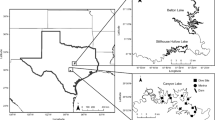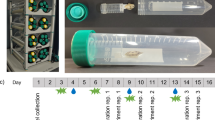Abstract
Experiments and field surveys were conducted in Hargus Lake (Ohio, U.S.) to investigate the effect of lake stratification on the survival, growth and distribution of zebra mussels. During the lake stratification period, relatively stable temperature and dissolved oxygen (DO) gradients persisted across the water column, allowing us to examine the chronic effect of hypoxia on zebra mussels. Zebra mussels were incubated in cages and suspended at different depths in the water column at both pelagic (max. depth = 12 m) and littoral (max. depth = 3.5 m) sites from April 18 to September 28, 1994. No mussel survived to the end of the experiment in cages ≥ 5.5 m, whereas the highest survival rate (76%) occurred at 5 m depth where temperature and DO remained fairly stable for at least 3 months. The threshold oxygen level for survival was between 1.0–1.7 mg l-1 when water temperature was at about 17–18 °C. While zebra mussels′ survival rate was not affected under the sublethal hypoxic conditions, their growth was greatly retarded by poor water quality. The field survey showed that the zebra mussels and macrophytes had about the same distribution and their biomasses were positively related. The percentage of mussels in aggregates increased towards their maximum distribution depth. The maximum distribution depth of the naturally occurring zebra mussels was only 2.8 m, whereas the adult mussels could survive the entire stratification period when being artificially placed on the 3.5 m bottom, and young mussels could colonize the 3.5 m bottom if solid substrates were provided. We conclude that lack of substrate, rather than hypoxia, was the limiting factor of zebra mussel distribution above 5 m depth in Hargus Lake.
Similar content being viewed by others
References
Berg, K., 1938. Studies on the bottom animals of Esrom Lake. D. Kgl. Danske Vidensk. Selsk. Skrifter, naturv. og math. Afd., 9. Række, VIII. 255 pp.
Berkman, P. A., M. A. Haltuch, E. Tichich, D. W. Garton, G.W. Kennedy, J. E. Gannon, S. D. Mackey, J. A. Fuller & D. L. Liebenthal, 1998. Zebra mussels invade Lake Erie muds. Nature 393: 27–28.
Bij de Vaate, A., 1991. Distribution and aspects of population dynamics of the zebra mussel, Dreissena polymorpha (Pallas, 1771), in the lake Ijsselmeer area (The Netherlands). Oecologia 86: 40–50.
Chen, L., A. G. Heath & R. J. Neves, 1997. Oxygen consumption and anaerobic metabolite changes of freshwater mussels (Unionidae) from different habitats during declining dissolved oxygen and air exposure. J. Shellfish Res. 16: 343.
Clarke, M. & R. F. McMahon, 1996. Effects of hypoxia and lowfrequency agitation on byssogenesis in the freshwater mussel Dreissena polymorpha (Pallas). Biol. Bull. 191: 413–420.
Coakley, J. P., G. R. Brown, S. E. Ioannou & M. N. Charlton, 1997. Colonization patterns and densities of zebra mussel Dreissena in muddy offshore sediments of western Lake Erie, Canada. Wat. Air and Soil Pollut. 99: 623–632.
Cullen, J. J., 1982. The deep chlorophyll maximum: comparing vertical profiles of chlorophyll a. Can. J. Fish. aquat. Sci. 39: 791–803.
Dame, R. F., 1996. Ecology of Marine Bivalves, An Ecosystem Approach. CRC Press, Boca Raton, 254pp.
Fahnenstiel, G. L. & H. J. Carrick, 1992. Phototrophic picoplankton in lakes Huron and Michigan: Abundance, distribution, composition and contribution to biomass and production. Can. J. Fish. aquat. Sci. 49: 379–388.
Gasol, J. M. & C. Pedros-Alió, 1991. On the origin of deep algal maxima: the case of Lake Cisó. Verh. int. Ver. Limnol. 24: 1024–1028.
Griffiths, C. L. & R. J. Griffiths, 1987. Bivalvia. In T. J. Pandian, & F. J. Vernberg (eds), Animal Energetics. Vol. 2. Academic Press, Inc., San Diego (CA): 1–88.
Johnson, P. D. & R. F. McMahon, 1997. Oxygen deprivation as a control measure for zebra mussel and Asian clams: how low should you go? Seventh International Zebra Mussel and Aquatic Nuisance Species Conference, New Orleans (LA): 50.
Lewandowski, K., 1982. The role of early developmental stages in the dynamics of Dreissena polymorpha (Pall.) Populations in lakes. II. Settling of larvae and the dynamics of numbers of settled individuals. Ekol. Pol. 30: 223–286.
Mackie, G. L., W. N. Gibbons, B. W. Muncaster & I. M. Gray, 1989. The zebra mussel, Dreissena polymorpha: a synthesis of European experiences and preview for North America. Ontario Ministry of the Environment, Water Resources Branch, Great Lakes Section, Toronto, Ontario.
Matthews, M. A. & R. F. McMahon, 1994. The survival of zebra mussels (Dreissena polymorpha) and Asian clams (Corbicula fluminea) under extreme hypoxia. In Proceedings: Fourth international zebra mussel conference '94. Wisconsin Sea Grant Institute, Madison, (Wisconsin): 231–249.
McMahon, R. F., 1996. The physiological ecology of the zebra mussel, Dreissena polymorpha, in North America and Europe. Am. Zool. 36: 339–363.
Mellina, E. & J. B. Rasmussen, 1994. Patterns in the distribution and abundance of zebra mussel (Dreissena polymorpha) in rivers and lakes in relation to substrate and other physicochemical factors. Can. J. Fish. aquat. Sci. 51: 1024–1036.
Mikheev, V. P., 1964. Mortality rate of Dreissena in anaerobic conditions. In B. K. Shtegman (Ed), Biology and Control of Dreissena. Academy of Sciences of the U.S.S.R., Institute of Biology of Inland Waters, Moscow (Russia): 65–68.
Moll, M. A. & E. F. Stoermer, 1982. A hypothesis relating trophic status and subsurface chlorophyll maxima of lakes. Arch. Hydrobiol. 94: 425–440.
Simpfendorfer, R.W., M. V. Vial, D. A. Lopez, M. Verdala & M. L. Gonzalez, 1995. Relationship between the aerobic and anaerobic metabolic capacities and the vertical distribution of three intertidal sessile invertebrates: Jehlius cirratus (Darwin) (Cirripedia), Perumytilus purpuratus (Lamarck) (Bivalvia) and Mytilus chilensis (Hupe) (Bivalvia). Comp. Biochem. Physiol. B. 111: 615–623.
Smit, H., A. Bij de Vaate & A. Fioole, 1992. Shell growth of the zebra mussel (Dreissena polymorpha (Pallas)) in relation to selected physicochemical parameters in the Lower Rhine and some associated lakes. Arch. Hydrobiol. 124: 257–280.
Sprung, M., 1992. Observations on shell growth and mortality of Dreissena polymorpha in lakes. In D. Neumann, & H. A. Jenner (Eds), The Zebra Mussel Dreissena polymorpha: Ecology, Biological Monitoring and First Applications in the Water Quality Management. Limnolgie Aktuell, Vol. 4. Gustav Fischer Verlag. Stuttgart, Jena, New York:19–28.
Sprung, M., 1995. Physiological energetics of the zebra mussel Dreissena polymorpha in lakes I. Growth and reproductive effort. Hydrobiologia. 304: 117–132.
Stanczykowska, A., 1977. Ecology of Dreissena polymorpha (Pall). (Bivalvia) in lakes. Pol. Arch. Hydrobiol. 24: 461–530.
Stanczykowska, A., 1984. The effect of various phosphorus loadings in the occurrence of Dreissena polymorpha (Pall). Limnologica (Berl.) 15: 535–539.
Summers, R. B., J. H. Thorp, J. E. Alexander, Jr. & R. D. Fell, 1996. Respiratory adjustment of dreissenid mussels (Dreissena polymorpha and Dreissena bugensis) in response to chronic turbidity. Can. J. Fish. aquat. Sci. 53: 1626–1631.
Walz, N., 1973. Studies on the biology of Dreissena polymorpha Pallas in the Lake of Constance. Arch. Hydrobiol. (Suppl.) 42: 452–482.
Wetzel, R. G. 1983. Limnology. 2nd edn. Saunders College Publishing. Philadelphia, PA.
Wisniewski, R., 1990. Shoals of Dreissena polymorpha as bioprocessor of seston. Hydrobiologia 200/201: 451–458.
Author information
Authors and Affiliations
Rights and permissions
About this article
Cite this article
Yu, N., Culver, D.A. In situ survival and growth of zebra mussels (Dreissena polymorpha) under chronic hypoxia in a stratified lake. Hydrobiologia 392, 205–215 (1999). https://doi.org/10.1023/A:1003697231917
Issue Date:
DOI: https://doi.org/10.1023/A:1003697231917




